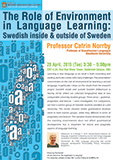
| News & Events |
| 28 April 2015 | |
The Role of Environment in Language Learning: Swedish inside and outside of Sweden Catrin Norrby Room 4.34, Run Run Shaw Tower, Centennial Campus HKU |
|
Learning a new language as an adult is both rewarding and exciting, but it also comes with many challenges. This presentation concentrates on the role of environment for learning a second language. In particular, I draw on the results from the research project Swedish inside and outside Sweden (Håkansson & Norrby 2010) where we collected longitudinal data in two comparable university student groups. One of the groups studied Swedish in the target-language environment, in Malmö, Sweden, whereas the other group lived and studied Swedish in Melbourne, Australia. Three areas – grammar, pragmatics and lexicon – were investigated. For the grammatical analysis we used the stages proposed by processability theory (Pienemann 1998). The pragmatic analysis was based on a gap-fill test, and for the lexical analysis an association test was used. For comparison, we had a control group of Swedish students enrolled at Lund University. The results showed similar grammatical development in both learner groups, while they differed in terms of pragmatics and lexicon. The variation found demonstrates that the learning environment does not affect grammatical development, but is important for lexical and pragmatic aspects of language learning. Håkansson, G. & Norrby, C. 2010. Environmental influence on language acquisition Comparing second and
foreign language acquisition of Swedish. Language Learning 60: 3: 628–650. |
|
